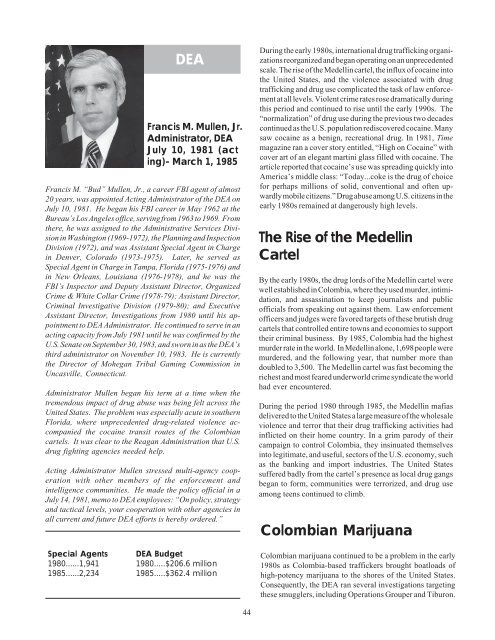Download This File - The Free Information Society
Download This File - The Free Information Society
Download This File - The Free Information Society
You also want an ePaper? Increase the reach of your titles
YUMPU automatically turns print PDFs into web optimized ePapers that Google loves.
DEA<br />
Francis M. Mullen, Jr.<br />
Administrator, DEA<br />
July 10, 1981 (acting)-<br />
March 1, 1985<br />
Francis M. “Bud” Mullen, Jr., a career FBI agent of almost<br />
20 years, was appointed Acting Administrator of the DEA on<br />
July 10, 1981. He began his FBI career in May 1962 at the<br />
Bureau’s Los Angeles office, serving from 1963 to 1969. From<br />
there, he was assigned to the Administrative Services Division<br />
in Washington (1969-1972), the Planning and Inspection<br />
Division (1972), and was Assistant Special Agent in Charge<br />
in Denver, Colorado (1973-1975). Later, he served as<br />
Special Agent in Charge in Tampa, Florida (1975-1976) and<br />
in New Orleans, Louisiana (1976-1978), and he was the<br />
FBI’s Inspector and Deputy Assistant Director, Organized<br />
Crime & White Collar Crime (1978-79); Assistant Director,<br />
Criminal Investigative Division (1979-80); and Executive<br />
Assistant Director, Investigations from 1980 until his appointment<br />
to DEA Administrator. He continued to serve in an<br />
acting capacity from July 1981 until he was confirmed by the<br />
U.S. Senate on September 30, 1983, and sworn in as the DEA’s<br />
third administrator on November 10, 1983. He is currently<br />
the Director of Mohegan Tribal Gaming Commission in<br />
Uncasville, Connecticut.<br />
Administrator Mullen began his term at a time when the<br />
tremendous impact of drug abuse was being felt across the<br />
United States. <strong>The</strong> problem was especially acute in southern<br />
Florida, where unprecedented drug-related violence accompanied<br />
the cocaine transit routes of the Colombian<br />
cartels. It was clear to the Reagan Administration that U.S.<br />
drug fighting agencies needed help.<br />
Acting Administrator Mullen stressed multi-agency cooperation<br />
with other members of the enforcement and<br />
intelligence communities. He made the policy official in a<br />
July 14, 1981, memo to DEA employees: “On policy, strategy<br />
and tactical levels, your cooperation with other agencies in<br />
all current and future DEA efforts is hereby ordered.”<br />
Special Agents DEA Budget<br />
1980......1,941 1980.....$206.6 million<br />
1985......2,234 1985.....$362.4 million<br />
44<br />
During the early 1980s, international drug trafficking organizations<br />
reorganized and began operating on an unprecedented<br />
scale. <strong>The</strong> rise of the Medellin cartel, the influx of cocaine into<br />
the United States, and the violence associated with drug<br />
trafficking and drug use complicated the task of law enforcement<br />
at all levels. Violent crime rates rose dramatically during<br />
this period and continued to rise until the early 1990s. <strong>The</strong><br />
“normalization” of drug use during the previous two decades<br />
continued as the U.S. population rediscovered cocaine. Many<br />
saw cocaine as a benign, recreational drug. In 1981, Time<br />
magazine ran a cover story entitled, “High on Cocaine” with<br />
cover art of an elegant martini glass filled with cocaine. <strong>The</strong><br />
article reported that cocaine’s use was spreading quickly into<br />
America’s middle class: “Today...coke is the drug of choice<br />
for perhaps millions of solid, conventional and often upwardly<br />
mobile citizens.” Drug abuse among U.S. citizens in the<br />
early 1980s remained at dangerously high levels.<br />
<strong>The</strong> Rise of the Medellin<br />
Cartel<br />
By the early 1980s, the drug lords of the Medellin cartel were<br />
well established in Colombia, where they used murder, intimidation,<br />
and assassination to keep journalists and public<br />
officials from speaking out against them. Law enforcement<br />
officers and judges were favored targets of these brutish drug<br />
cartels that controlled entire towns and economies to support<br />
their criminal business. By 1985, Colombia had the highest<br />
murder rate in the world. In Medellin alone, 1,698 people were<br />
murdered, and the following year, that number more than<br />
doubled to 3,500. <strong>The</strong> Medellin cartel was fast becoming the<br />
richest and most feared underworld crime syndicate the world<br />
had ever encountered.<br />
During the period 1980 through 1985, the Medellin mafias<br />
delivered to the United States a large measure of the wholesale<br />
violence and terror that their drug trafficking activities had<br />
inflicted on their home country. In a grim parody of their<br />
campaign to control Colombia, they insinuated themselves<br />
into legitimate, and useful, sectors of the U.S. economy, such<br />
as the banking and import industries. <strong>The</strong> United States<br />
suffered badly from the cartel’s presence as local drug gangs<br />
began to form, communities were terrorized, and drug use<br />
among teens continued to climb.<br />
Colombian Marijuana<br />
Colombian marijuana continued to be a problem in the early<br />
1980s as Colombia-based traffickers brought boatloads of<br />
high-potency marijuana to the shores of the United States.<br />
Consequently, the DEA ran several investigations targeting<br />
these smugglers, including Operations Grouper and Tiburon.

















